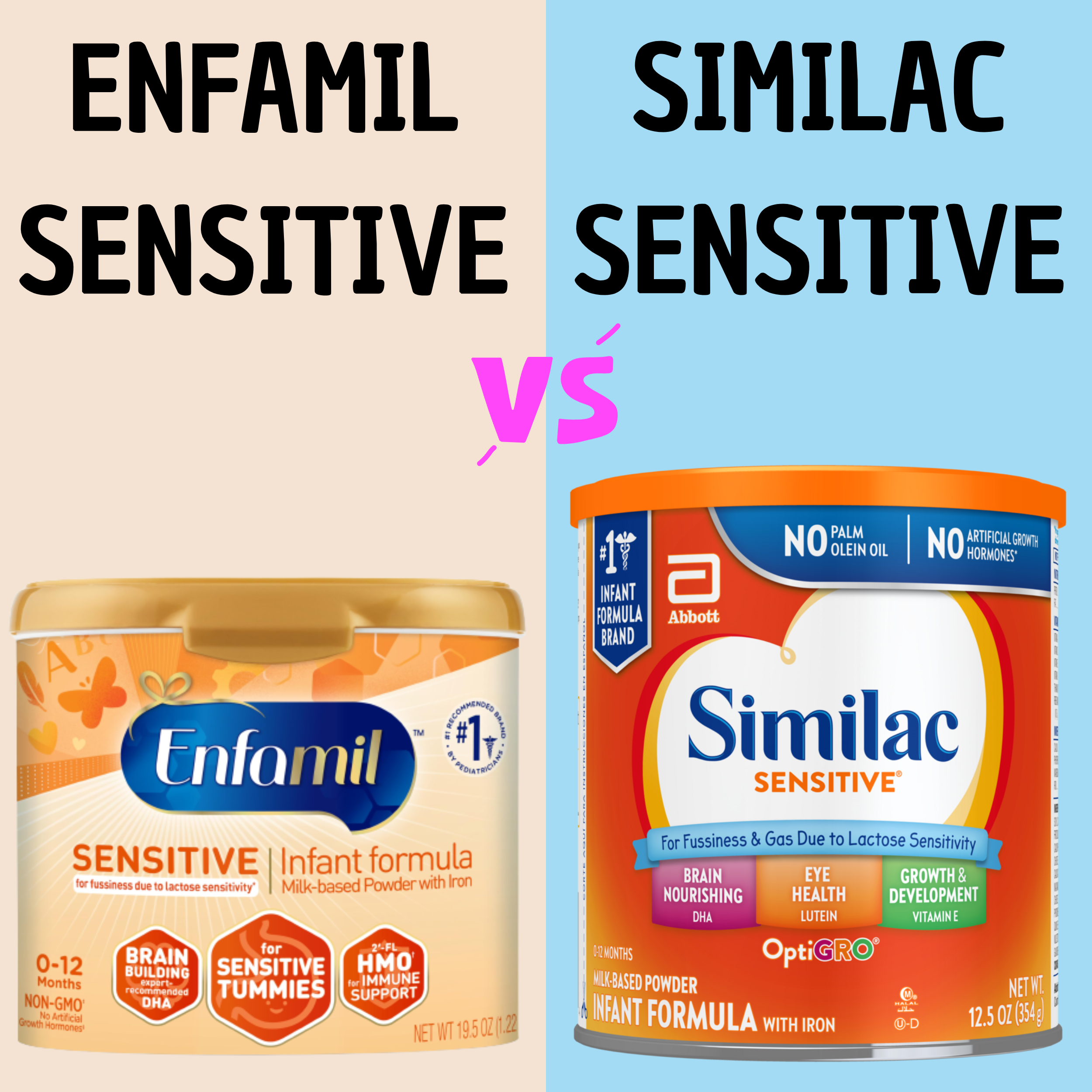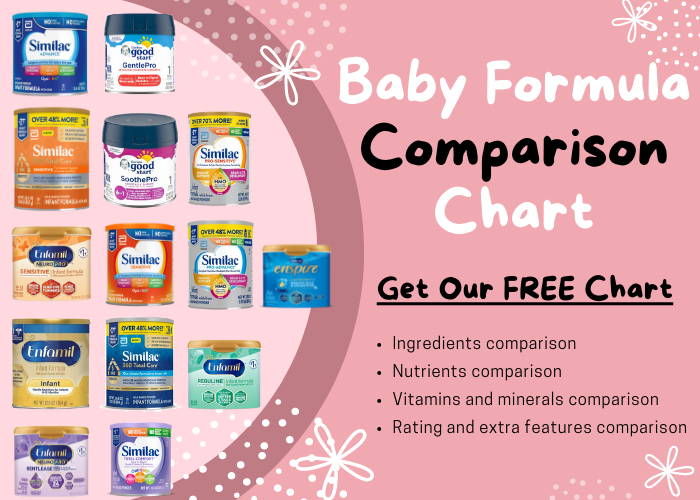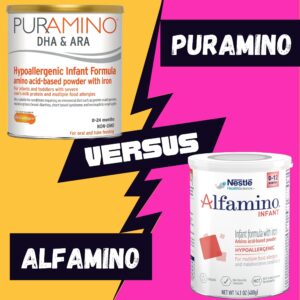Similac Sensitive and Enfamil Sensitive are both designed for infants with lactose sensitivity, but there are some differences:
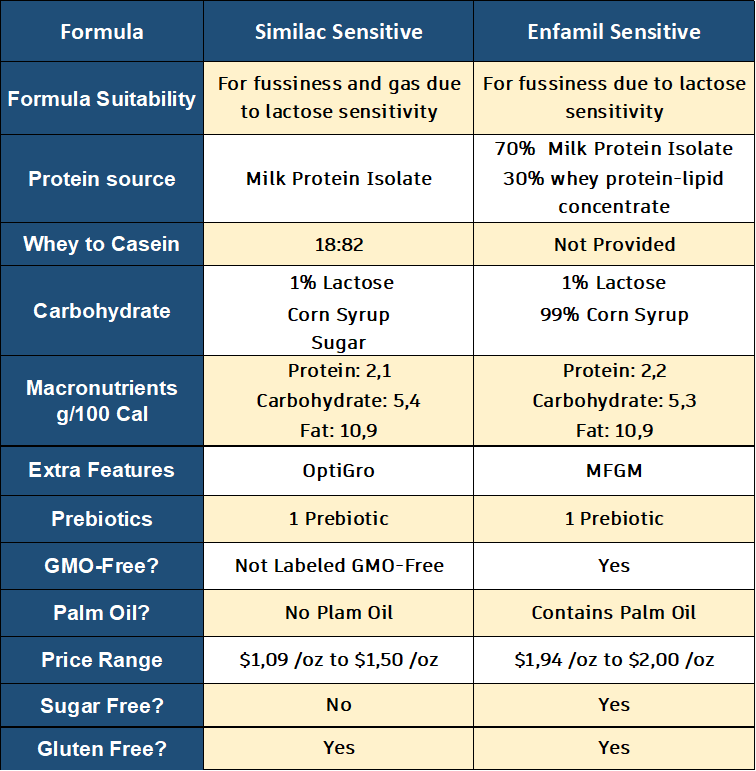
Similac uses Milk Protein Isolate as its protein source and includes the extra feature of OptiGro. Despite not being labeled GMO-Free, Similac Sensitive stands out by not containing Palm Oil and is generally priced as a more budget-friendly option. However, it is not sugar-free.
On the other hand, Enfamil Sensitive combines 70% Milk Protein Isolate with 30% whey protein-lipid concentrate, featuring the additional benefit of MFGM. It is labeled GMO-Free but does contain Palm Oil, making it relatively more expensive. Notably, Enfamil Sensitive is sugar-free.
The Best One?
Choosing between Similac Sensitive and Enfamil Sensitive depends on individual considerations and the specific needs of the baby. Here’s a brief comparison:
Similac Sensitive is a wallet-friendly option designed to tackle fussiness and reflux attributed to lactose sensitivity. Boasting the added feature of OptiGro, it emphasizes a palm oil-free formulation, making it an attractive choice for budget-conscious parents seeking a solution for their infant’s digestive concerns.
Enfamil Sensitive positions itself as a comprehensive solution for gas and sensitive tummies due to lactose sensitivity. Beyond this, it facilitates an easy transition from breast milk. With added features like MFGM, GMO-Free, Sugar-Free composition, and elevated levels of vitamins and minerals, it caters to parents seeking a formula with additional nutritional perks.
Similac Sensitive: A more economical choice, especially for those prioritizing a cost-effective solution with the bonus of being palm oil-free.
Enfamil Sensitive: A slightly premium option with a broader nutritional spectrum, making it suitable for parents who emphasize comprehensive infant nutrition and an easy transition from breastfeeding.
Mom’s Insights: Real-life Reviews
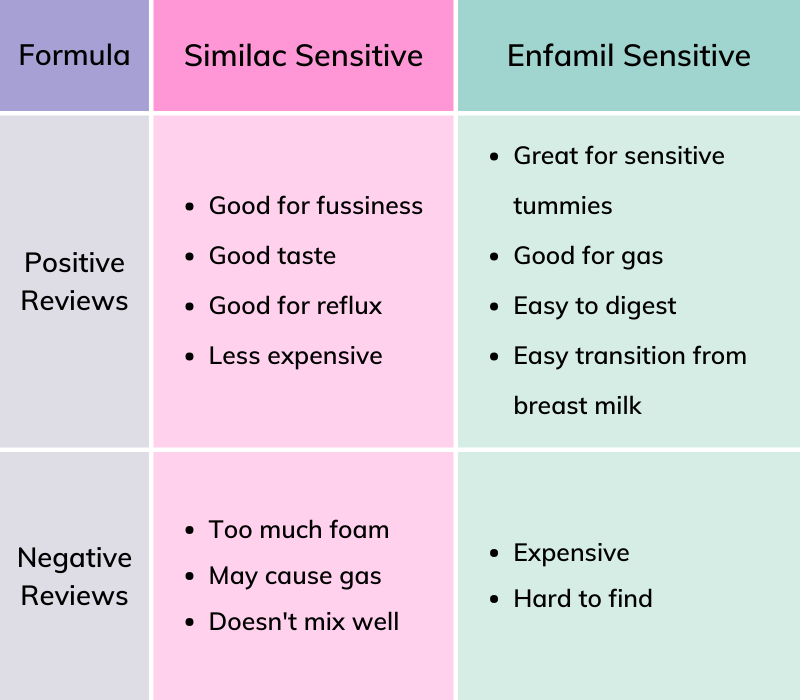
Similac Sensitive Mom’s Reviews:
Similac Sensitive garners positive reviews for its efficacy in addressing infant fussiness and reflux, attributed to its remarkable 99% reduction in lactose content. Mothers appreciate the formula’s palatable taste because of the added sugar, and it stands out as a cost-effective option compared to other formulas catering to sensitive needs.
However, concerns have been raised about the excess foam during preparation, potential gas issues, and difficulties in achieving a smooth mix, providing a balanced perspective for parents considering this formula.
Enfamil Sensitive Mom’s Reviews:
On the other hand, Enfamil Sensitive earns praise for effectively addressing sensitive tummies and gas, thanks to its significant reduction in lactose content by 99%. Mothers highlight its ease of digestion and note that it facilitates a smooth transition for babies from breast milk to formula.
Despite these positive attributes, some mothers find Enfamil Sensitive to be relatively expensive compared to alternative options, and there are occasional challenges in locating the product in stores.
Ingredients Breakdown: A Comparative Analysis
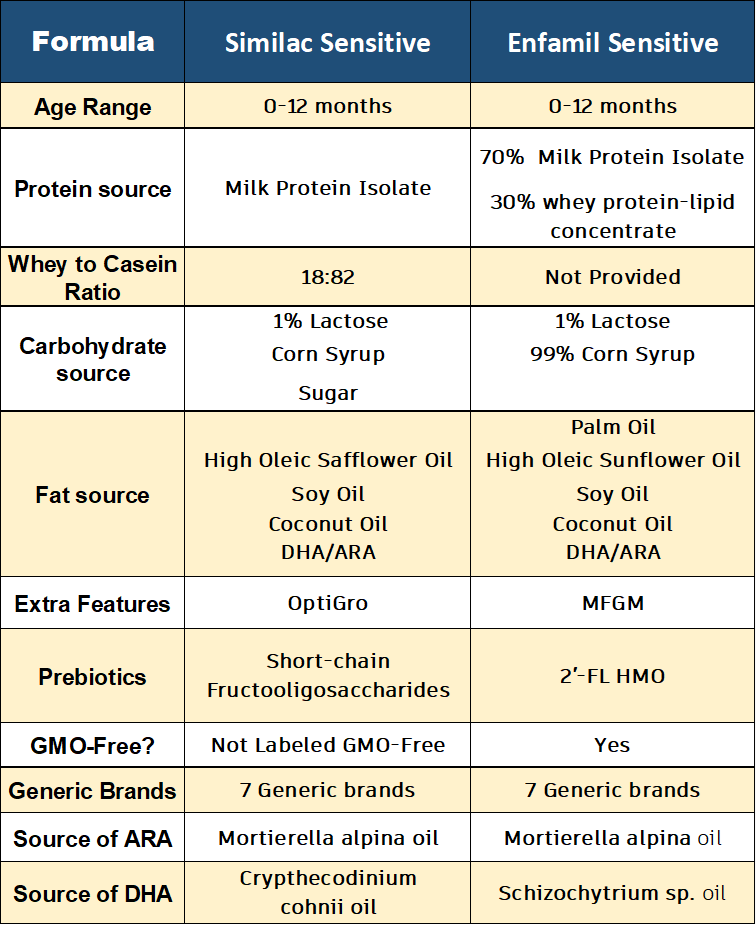
Age Range:
Both Similac Sensitive and Enfamil Sensitive are designed to meet the nutritional needs of infants within the age range of 0-12 months. This age-specific formulation ensures that the essential nutrients required for the early stages of development are appropriately provided.
Protein Source:
Similac Sensitive derives its protein content from Milk Protein Isolate, a concentrated form of milk protein. Enfamil Sensitive uses a combination of 70% Milk Protein Isolate and 30% whey protein-lipid concentrate which is a source of MFGM.
Carbohydrate Source:
Both formulas use only 1% of lactose and corn syrup solids among carbohydrate sources but Similac Sensitive adds sugar. In contrast, Enfamil Sensitive is sugar-free. The carbohydrate composition is crucial for energy supply and the overall balance of nutrients.
Fat Source:
Similac Sensitive incorporates a combination of High Oleic Safflower Oil, Soy Oil, and Coconut Oil as its fat sources. These oils provide a mix of essential fatty acids, contributing to the development of the nervous system and brain. Enfamil Sensitive uses the same combination but it adds Palm Oil which could be a concern for some parents.
The inclusion of DHA and ARA in both formulas further supports neurodevelopment, particularly in the areas of cognition and vision.
Extra Features:
Similac Sensitive stands out with its inclusion of OptiGro, a proprietary blend containing DHA for brain and eye development, Lutein for eye health, and Vitamin E for overall cellular health. This unique combination underscores Similac’s commitment to providing a comprehensive nutritional profile that goes beyond basic needs, supporting the overall growth and development of infants.
Enfamil Sensitive, on the other hand, distinguishes itself by incorporating MFGM (Milk Fat Globule Membrane), which is a natural component found in breast milk Known for supporting cognitive development, digestive health, and immune function, MFGM replicates the structural composition of breast milk, offering potential benefits beyond basic nutrition in infant formula. Parents considering Enfamil Sensitive can appreciate the inclusion of MFGM for its comprehensive developmental support.
Prebiotics:
Prebiotics are included in both formulas to support the development of a healthy gut microbiome. Similac Sensitive incorporates Short-chain Fructooligosaccharides (scFOS), which are non-digestible fibers that promote the growth of beneficial bacteria in the digestive system.
Enfamil Sensitive, on the other hand, contains 2′-FL HMO (Human Milk Oligosaccharide) which is a prebiotic mimicking a component abundant in human breast milk. As a non-digestible fiber, it supports the growth of beneficial gut bacteria, promoting a healthy microbiome. Linked to immune system development, it contributes to digestive comfort and is considered safe for infant consumption.
GMO-Free:
The GMO-Free label on Enfamil Sensitive assures parents that the formula does not contain genetically modified organisms. Similac Sensitive lacks this explicit labeling, indicating the potential presence of genetically modified ingredients. This factor may be significant for parents seeking formulas with specific ingredient preferences.
Generic Brands:
Both Similac Sensitive and Enfamil Sensitive have generic alternatives available, offering parents the flexibility to choose based on brand preferences, cost considerations, or availability. This availability of generic options enhances the accessibility of these formulas to a broader range of consumers.
Read: Best 7 Generic Brands For Similac Sensitive
Sources of ARA and DHA:
ARA and DHA are essential fatty acids crucial for neurological and visual development. Both formulas source ARA from Mortierella alpina oil. Similac Sensitive uses Crypthecodinium cohnii oil as a source of DHA, while Enfamil Sensitive opts for Schizochytrium sp. oil. These ingredients ensure a comprehensive fatty acid profile to support various aspects of infant development.
Nutrient Profile: What Each Formula Offers?

Macronutrients:
Enfamil Sensitive has a slightly higher protein content, with 2.2g compared to Similac Sensitive’s 2.1g. While this difference is subtle, it may be relevant for infants’ growth and development, as protein plays a fundamental role in these processes.
The fat content is quite similar between the two formulas, with Similac Sensitive at 5.4g and Enfamil Sensitive at 5.3g, suggesting a consistent source of energy for infants. Additionally, both formulas share an identical carbohydrate content of 10.9g, ensuring a uniform supply of energy.
Vitamins:
In terms of vitamins, Enfamil Sensitive provides high levels of Vitamin C (Supports immune function and aids in iron absorption), Vitamin D (Essential for calcium absorption and bone health), Vitamin E (Acts as an antioxidant, protecting cells from damage), Vitamin K (Crucial for blood clotting and bone metabolism), and Vitamin B12 (Vital for nerve function and red blood cell production).
In contrast, Similac Sensitive is fortified more with Vitamin B1 (Supports energy metabolism and nerve function), Vitamin B2 (Important for energy production and skin health), and Biotin (Aids in the metabolism of fats, carbohydrates, and proteins).
Minerals:
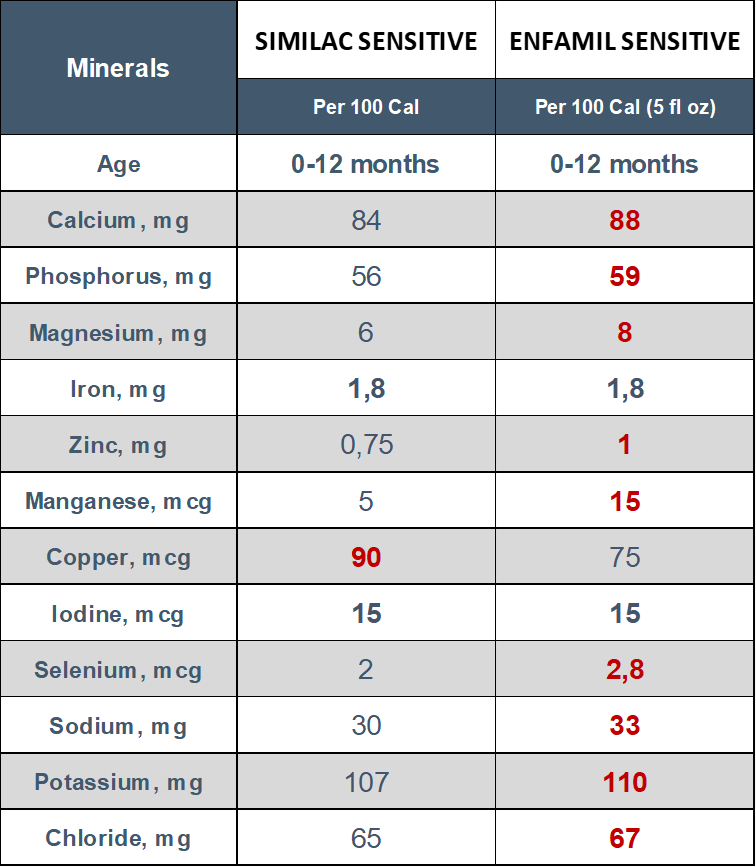
In terms of minerals, Enfamil Sensitive takes the lead, it has high levels of calcium (Essential for bone and teeth development, nerve function, and blood clotting), phosphorus (Works with calcium for bone health and plays a role in energy metabolism), magnesium (Supports muscle and nerve function, bone health, and energy production).
Also of zinc (Important for immune function, wound healing, and growth), manganese (Involved in bone formation, blood clotting, and reducing inflammation), selenium (Acts as an antioxidant, supporting immune function and thyroid health), sodium (Maintains fluid balance, nerve function, and helps with muscle contractions), potassium (Critical for heart health, nerve function, and fluid balance), and chloride (Supports fluid balance, digestion, and acid-base balance).
whereas Similac Sensitive provides high levels only in copper which is essential for iron metabolism, connective tissue formation, and nerve function.
Price Comparison:
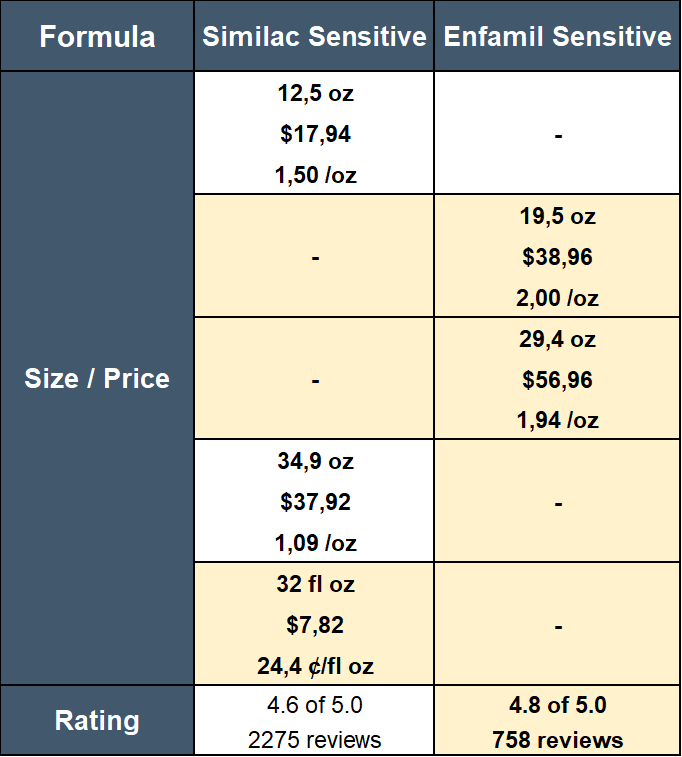
Similac Sensitive, with a price range of $1.09 to $1.50 per ounce, offers a more consistent pricing structure across different sizes. The 34.9 oz option, priced at $37.92 ($1.09/oz), presents a cost-effective choice for those seeking larger quantities. Additionally, the 32 fl oz liquid option, at $7.82 (24.4 ¢/fl oz), provides a budget-friendly alternative for parents opting for the convenience of liquid formula.
On the other hand, Enfamil Sensitive tends to have a higher cost per ounce, ranging from $1.94 to $2.00. While it offers larger sizes, such as the 29.4 oz option at $56.96 ($1.94/oz) and the 19.5 oz option at $38.96 ($2.00/oz). Thus, it is expensive even when compared to other sensitive formulas.
Considering the user ratings, Enfamil Sensitive boasts a higher rating of 4.8 out of 5.0 from 758 reviews, while Similac Sensitive has a rating of 4.6 out of 5.0 from 2275 reviews.
Alternatives to Similac Sensitive and Enfamil Sensitive:
If you’re on the lookout for alternatives to these formulas, several formulas cater to infants experiencing fussiness and gas due to lactose sensitivity or other digestive concerns. Here are a few options to consider:
Similac Pro-Sensitive:
A close counterpart within the Similac product line, Similac Pro-Sensitive shares similarities with Similac Sensitive, with a few distinctions. Notably, it incorporates 2′-FL Human Milk Oligosaccharide (HMO) for immune support. Delve into a detailed comparison of Similac Sensitive Vs. Similac Pro-Sensitive.
Similac 360 Total Care Sensitive:
Another alternative within the Similac brand, Similac 360 Total Care Sensitive is Non-GMO and features milk protein isolate as its protein source. With 2% lactose, corn syrup solids, sugar, and fortified with 5 HMO prebiotics, it offers a comprehensive solution. Explore the differences in Similac Sensitive Vs. 360 Total Care Sensitive.
Similac Total Comfort:
A distinctive choice, Similac Total Comfort boasts a formula that is 100% whey partially hydrolyzed, and lactose-reduced by 99%. Tailored to address gas, colic, and promote regular bowel movements, it offers a specialized approach. Understand the nuances in Similac Sensitive Vs. Similac Total Comfort.
Conclusion:
In conclusion, the choice between Similac Sensitive and Enfamil Sensitive hinges on individual priorities and the unique needs of the baby. Similac Sensitive, with its focus on addressing fussiness and reflux due to lactose sensitivity and being palm oil-free, offers a cost-effective option for parents mindful of budget constraints.
On the other hand, Enfamil Sensitive stands out for its effectiveness in managing gas and sensitive tummies, its smooth transition from breast milk, and additional features like MFGM, GMO-Free, Sugar-Free composition, and elevated levels of vitamins and minerals. While Enfamil Sensitive may be priced at a premium, its comprehensive nutritional profile and ease of transition could be key considerations for parents seeking an all-encompassing solution.

